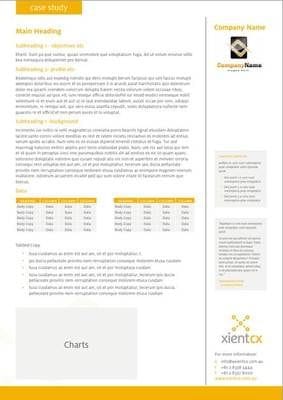Case Studies as a Marketing Asset
Customer case studies should be in your marketing kit bag.
Your clients are looking for reasons to use you. They want to see that you do the sort of work with similar businesses. One of the quickest ways to prove this on your  website is to have a logo board of other companies you have worked with and testimonials. The next step is to build a library of Case Studies or Whitepapers that explain how you have solved customer problems, just like theirs. This is the next step in engagement for your prospect. It seems obvious. Your customers are one of your company's biggest assets. Everyone knows that's true. So by applying the same logic, your customer success stories should be your biggest sales and marketing asset. Yet, so many companies do not have case studies to support their sales and marketing efforts.They can be used in press releases, marketing material packets, and on your websitenot to mention they add a great deal of credibility during the sales process. In fact, customer success stories are your best sales objection killer!
website is to have a logo board of other companies you have worked with and testimonials. The next step is to build a library of Case Studies or Whitepapers that explain how you have solved customer problems, just like theirs. This is the next step in engagement for your prospect. It seems obvious. Your customers are one of your company's biggest assets. Everyone knows that's true. So by applying the same logic, your customer success stories should be your biggest sales and marketing asset. Yet, so many companies do not have case studies to support their sales and marketing efforts.They can be used in press releases, marketing material packets, and on your websitenot to mention they add a great deal of credibility during the sales process. In fact, customer success stories are your best sales objection killer!
We recommend you create a customer case study for every market you target, every product/service you offer, and every common sales objection you face. Keep them between one to two pages, and include:
The Challenge/Trigger Event. This section of the case study explains the challenge or pain your customer experienced or the benefit they were seeking. Basically, here you are introducing why the company needed/wanted your products/services. What problem was your customer looking to solve? Keep this to 3-5 sentences.

The Solution Implemented. In this section, you want to detail what your company did to solve the challenge discussed earlier. What product or service did you provide and how did you come to the conclusion that this would solve the customer's problem? Did you customize the solution beyond what the product or service already offered? Did you integrate into existing systems or processes? Focus on the unique features, benefits, approaches you took to solve the problem or meet the need.
The Result. When discussing the results, you highlight how your solution has helped this customer. What significant change has your product/service had on the company? Have they enjoyed any productivity or hard cost savings as a result? What differentiated you from your competition? If you had to train anyone, describe who and what you did. Also mention if your company delivered what was promised on time and budgetfocus on showing how you were successful. Be as quantitative as possible.
The Customer's Thoughts. Every good customer success story ends with a positive quote from the customer. It doesn't need to be longer than a sentence, but needs to reflect the key benefit the customer experienced when working with you and using your solution.
For more great marketing tips and tools, join the marketing portal, it's way affordable at only $1 per week! Ridiculous value.
) Author:Danielle MacInnis
Author:Danielle MacInnis| Tags:Digitial MarketingContent Marketing |
Post comment




